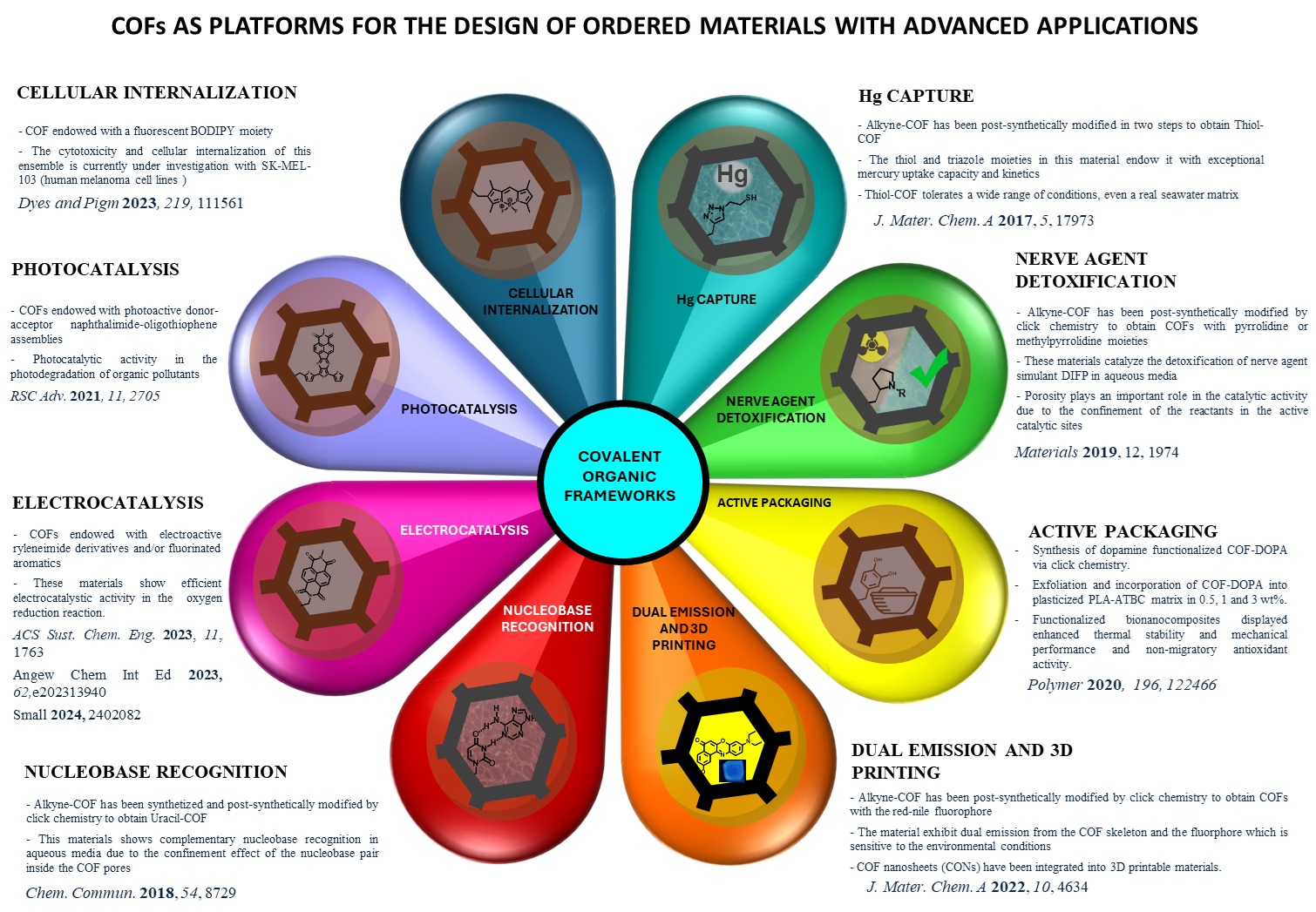Covalent Organic Frameworks

COVALENT ORGANIC FRAMEWORKS
Publications:
- Unconventional Fast Room Temperature Synthesis of Covalent Organic Framework Single Crystals Unveiling Precise Structural Insights, Angew. Chem. Int. Ed. (2025) (Accepted, DOI: 10.1002/anie.202510312)
- Nile Red-Based Covalent Organic Framework as a Photocatalyst for C-H Bond Functionalization, ACS Catal, 15, 10736 (2025)
- Post-synthetic modification of covalent organic frameworks with active manganese centers for electrocatalytic CO2 reduction in water, J. Mater. Chem. A, 13, 1142 (2025)
- Boosting Photoconductivity by Increasing the Structural Complexity of Multivariate Covalent Organic Frameworks, Small 21, 2406211 (2025)
- Ionic Covalent Organic Framework as Antibacterial Additive for Biobased Polymers, ACS Appl. Mat. Interf. 16, 70883-70890 (2024)
- Robust Amide-Linked Fluorinated Covalent Organic Framework for Long-Term Oxygen Reduction Reaction Electrocatalysis, Small 20, 202402082 (2024)
- Turn-on Solid-State Fluorescent determination of Zinc Ion by Quinoline-based Covalent Organic Framework, Macromol. Rapid Commun. 45, 202400134 (2024)
- Exploring Advanced Oxygen Reduction Reaction Electrocatalysts: The Potential of Metal-Free and Non-Pyrolyzed Covalent Organic Frameworks, ChemSusChem, 17, 202400558 (2024)
- Scalable Synthesis and Electrocatalytic Performance of Highly Fluorinated Covalent Organic Frameworks for Oxygen Reduction, Angew. Chem. Int. Ed. 62, e202313940 (2023)
-
BODIPY doping of Covalent Organic Frameworks-based nanomaterials: a novel strategy towards biomedical applications, Dyes and Pigm. 219, 111561 (2023)
-
Environmental impact analysis of surface printing and 3D inkjet printing applications using an imine based covalent organic framework: A Life Cycle Assessment study, J. Clean. Prod. 395, 136381 (2023)
-
Evaluation of the oxygen reduction reaction electrocatalytic activity of post-synthetically modified covalent organic frameworks, ACS Sustain. Chem. Eng. 11, 1763 (2023)
- Cycloadditions and Cyclization Reactions via Post-Synthetic Modification and/or One-Pot Methodologies for the Stabilization of Imine-Based Covalent Organic Frameworks, Encyclopedia 3, 795 (2023)
- Pyrenetetraone-based covalent organic framework as an effective electrocatalyst for oxygen reduction reaction, Nano Res. 15, 3907 (2022).
- Following the light: 3D-printed COF@poly(2-hydroxyethyl methacrylate) dual emissive composite with response to polarity and acidity, J. Mat. Chem. A, 10, 4634 (2022).
- Covalent organic frameworks based on electroactive naphthalenediimide as active electrocatalysts toward oxygen reduction reaction, Appl. Mater. Today, 26, 101384 (2202).
- Electrochemical (Bio)Sensors Based on Covalent Organic Frameworks (COFs), Sensors, 22, 4758 (2022).
- Photocatalytic degradation of organic pollutants through conjugated poly(azomethine) networks based on terthiophene–naphthalimide assemblies, RSC Advances, 11, 2701 (2021).
- Acidic triggering of reversible electrochemical activity in a pyrenetetraone-based 2D polymer, Polymer, 212, 123273 (2021).
- Plasticized poly(lactic acid) reinforced with antioxidant covalent organic frameworks (COFs) as novel nanofillers designed for non-migrating active packaging applications, Polymer, 196, 122466 (2020).
- Oxygen reduction using a metal-free naphthalene diimide-based covalent organic framework electrocatalyst Chem. Commun., 56,_1267 (2020).
- Gas-Solid Heterogeneous Post-Synthetic Modification of Imine-based Covalent Organic Frameworks, Eur.J. 26,6495 (2020).
- Synergistic Effect of Covalent Bonding and Physical Encapsulation of Sulfur in the Pores of a Microporous COF to Improve Cycling Performance in Li-S Batteries”, Chem. Eur. J. 25, 12394 (2019).
- Catalytically Active Imine-based Covalent Organic Frameworks for Detoxification of Nerve Agent Simulants in Aqueous Media, Materials 12, 1974 (2019).
- Post-synthetic modification of covalent organic frameworks”, Chem. Soc. Rev. 48, 3903 (2019).
- Introduction to Covalent Organic Frameworks: An Advanced Organic Chemistry Experiment”, J. Chem. Educ. 96, 1745 (2019).
- Uracil grafted imine-based covalent organic framework for nucleobase recognition, Chem. Commun. 54, 8729 (2018)
- Thiol Grafted Imine-Based Covalent Organic Framework for Water Remediation Through Selective Removal of Hg(II)”, J. Mat. Chem. A 5, 17973 (2017)
- An Aza-Fused π-Conjugated Microporous Framework Catalyzes the Production of Hydrogen Peroxide, ACS Catal. 7, 1015 (2017).
- Covalent Organic Frameworks based on Schiff-base Chemistry. Synthesis and applications Soc. Rev. 45, 5635 (2016)
- Surface Patterning of a Crystalline Laminar Covalent Organic Framework Synthesized at Room Temperature Eur. J. 21, 10666 (2015)
- Method for the Synthesis of Covalent Organic Frameworks, European Patent Ref.: 13382313.8-1306 (2013).
